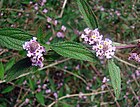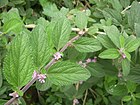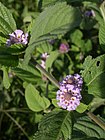Note: This is a project under development. The articles on this wiki are just being initiated and broadly incomplete. You can Help creating new pages.
Difference between revisions of "Lippia alba - Bushy matgrass"
(→References) |
|||
| (21 intermediate revisions by 2 users not shown) | |||
| Line 1: | Line 1: | ||
| − | |||
| − | |||
[[File:Lippia alba.jpg|thumb|right|''Lippia alba'', ''bushy matgrass'']] | [[File:Lippia alba.jpg|thumb|right|''Lippia alba'', ''bushy matgrass'']] | ||
| − | + | '''Lippia alba''' is a species of Flowering plant in the verbena family Verbenaceae. It is native to southern Texas in the United States, Mexico, the Caribbean, Central America, and South America. | |
| − | '''Lippia alba''' is a species of Flowering plant in the verbena family | ||
| − | |||
==Uses== | ==Uses== | ||
| − | {{Uses| | + | {{Uses|Heart problems}}, {{Uses|Fever}}, {{Uses|Stomachache}}, {{Uses|Cleanse the bladder}}, {{Uses|Blotches}}, {{Uses|Pimples}}, {{Uses|Diarrhea}}, {{Uses|Sore throats}}. |
==Parts Used== | ==Parts Used== | ||
| − | {{Parts Used| | + | {{Parts Used|Leaves}}. |
==Chemical Composition== | ==Chemical Composition== | ||
The plant contains an essential oil composed principally of dihydrocarvone. Other compounds include limonene, pinene, linalol, and camphor. | The plant contains an essential oil composed principally of dihydrocarvone. Other compounds include limonene, pinene, linalol, and camphor. | ||
| + | |||
==Common names== | ==Common names== | ||
| − | {{Common names|kn=|ml=|sa=|ta=|te=|hi=|en= | + | {{Common names|kn=|ml=|sa=|ta=|te=|hi=|en=Bushy Lippia, Bushy mat grass}} |
| + | |||
| + | ==Properties== | ||
| + | Reference: Dravya - Substance, Rasa - Taste, Guna - Qualities, Veerya - Potency, Vipaka - Post-digesion effect, Karma - Pharmacological activity, Prabhava - Therepeutics. | ||
| + | ===Dravya=== | ||
| + | |||
| + | ===Rasa=== | ||
| + | |||
| + | ===Guna=== | ||
| + | |||
| + | ===Veerya=== | ||
| + | |||
| + | ===Vipaka=== | ||
| + | |||
| + | ===Karma=== | ||
| + | |||
| + | ===Prabhava=== | ||
==Habit== | ==Habit== | ||
| Line 21: | Line 34: | ||
==Identification== | ==Identification== | ||
===Leaf=== | ===Leaf=== | ||
| − | {{Leaf| | + | {{Leaf|Opposite|Elliptic-oblong|Leaves are 4-9 x 2-4 cm, thick-chartaceous lateral nerves 6-8 pairs, the lowest pair longer and prominent, nerves impressed above, raised below.}}<ref name="Leaf"/> |
===Flower=== | ===Flower=== | ||
| − | {{Flower| | + | {{Flower|Ovate-lanceolate|1.5 cm|Pinkish-white|Stamens 4|Flowers zygomorphic, 5-merous, subsessile, aggregated in elongate}} |
===Fruit=== | ===Fruit=== | ||
| − | {{Fruit|| | + | {{Fruit|Pear-shaped|2 x 1.5 mm hard|Bushy Lippia is native of South America, naturalized in parts of India|With hooked hairs|2-seeded}} |
===Other features=== | ===Other features=== | ||
==List of Ayurvedic medicine in which the herb is used== | ==List of Ayurvedic medicine in which the herb is used== | ||
| − | |||
==Where to get the saplings== | ==Where to get the saplings== | ||
| Line 39: | Line 51: | ||
==How to plant/cultivate== | ==How to plant/cultivate== | ||
| − | Prefers a position in full sun in any moderately fertile, well-drained soil<ref name="How to plant/cultivate"/> | + | Prefers a position in full sun in any moderately fertile, well-drained soil.<ref name="How to plant/cultivate"/> |
==Commonly seen growing in areas== | ==Commonly seen growing in areas== | ||
| − | {{Commonly seen| | + | {{Commonly seen|Tropical area}}, {{Commonly seen|Subtropical area}} |
==Photo Gallery== | ==Photo Gallery== | ||
<gallery class="left" caption="" widths="140px" heights="140px"> | <gallery class="left" caption="" widths="140px" heights="140px"> | ||
| − | + | Lippia alba (11627884485).jpg | |
| − | + | Lippia alba 01.jpg | |
| − | + | Lippia alba 02.jpg | |
| − | + | Lippia alba 03.jpg | |
| + | Lippia alba 04.jpg | ||
| + | Lippia alba 05.jpg | ||
| + | Lippia alba 06.jpg | ||
| + | Lippia alba var. lanceolata.jpg | ||
| + | Lippia alba.jpg | ||
</gallery> | </gallery> | ||
| Line 55: | Line 72: | ||
<references> | <references> | ||
| − | <ref name=" | + | <ref name="Leaf">[https://www.flowersofindia.net/catalog/slides/Bushy%20Lippia.htmll Flowers of india]</ref> |
| − | + | <ref name="How to plant/cultivate">[http://tropical.theferns.info/viewtropical.php?id=Lippia+alba Cultivation Details]</ref> | |
| − | |||
| − | <ref name="How to plant/cultivate">[http://tropical.theferns.info/viewtropical.php?id=Lippia+alba | ||
</references> | </references> | ||
==External Links== | ==External Links== | ||
| − | * [https://www.flowersofindia.net/catalog/slides/Bushy%20Lippia.html] | + | * [https://www.flowersofindia.net/catalog/slides/Bushy%20Lippia.html Lippia alba on flowers of india] |
| − | * [https://scialert.net/abstract/?doi=rjmp.2012.334.340] | + | * [https://scialert.net/abstract/?doi=rjmp.2012.334.340 Lippia alba on Research Journal of Medicinal Plants] |
| − | * [http://thinkinglaymen.org.in/plant_details.php?id= | + | * [http://thinkinglaymen.org.in/plant_details.php?id=531Plant Characteristics of Lippia alba] |
| − | * [https://www.naturalmedicinefacts.info/plant/lippia-alba.html] | + | * [https://www.naturalmedicinefacts.info/plant/lippia-alba.html Lippia alba on natural medicine facts] |
| − | + | ||
[[Category:Herbs]] | [[Category:Herbs]] | ||
| + | [[Category:Ayurvedic herbs that don't have flower, fruit and leaf photos]] | ||
| + | [[Category:Ayurvedic herbs that don't have seed photos]] | ||
| + | [[Category:Verbenaceae]] | ||
Latest revision as of 11:35, 4 June 2020
Lippia alba is a species of Flowering plant in the verbena family Verbenaceae. It is native to southern Texas in the United States, Mexico, the Caribbean, Central America, and South America.
Contents
- 1 Uses
- 2 Parts Used
- 3 Chemical Composition
- 4 Common names
- 5 Properties
- 6 Habit
- 7 Identification
- 8 List of Ayurvedic medicine in which the herb is used
- 9 Where to get the saplings
- 10 Mode of Propagation
- 11 How to plant/cultivate
- 12 Commonly seen growing in areas
- 13 Photo Gallery
- 14 References
- 15 External Links
Uses
Heart problems, Fever, Stomachache, Cleanse the bladder, Blotches, Pimples, Diarrhea, Sore throats.
Parts Used
Chemical Composition
The plant contains an essential oil composed principally of dihydrocarvone. Other compounds include limonene, pinene, linalol, and camphor.
Common names
| Language | Common name |
|---|---|
| Kannada | |
| Hindi | |
| Malayalam | |
| Tamil | |
| Telugu | |
| Marathi | NA |
| Gujarathi | NA |
| Punjabi | NA |
| Kashmiri | NA |
| Sanskrit | |
| English | Bushy Lippia, Bushy mat grass |
Properties
Reference: Dravya - Substance, Rasa - Taste, Guna - Qualities, Veerya - Potency, Vipaka - Post-digesion effect, Karma - Pharmacological activity, Prabhava - Therepeutics.
Dravya
Rasa
Guna
Veerya
Vipaka
Karma
Prabhava
Habit
Identification
Leaf
| Kind | Shape | Feature |
|---|---|---|
| Opposite | Elliptic-oblong | Leaves are 4-9 x 2-4 cm, thick-chartaceous lateral nerves 6-8 pairs, the lowest pair longer and prominent, nerves impressed above, raised below. |
Flower
| Type | Size | Color and composition | Stamen | More information |
|---|---|---|---|---|
| Ovate-lanceolate | 1.5 cm | Pinkish-white | Stamens 4 | Flowers zygomorphic, 5-merous, subsessile, aggregated in elongate |
Fruit
| Type | Size | Mass | Appearance | Seeds | More information |
|---|---|---|---|---|---|
| Pear-shaped | 2 x 1.5 mm hard | Bushy Lippia is native of South America, naturalized in parts of India | With hooked hairs | 2-seeded | {{{6}}} |
Other features
List of Ayurvedic medicine in which the herb is used
Where to get the saplings
Mode of Propagation
How to plant/cultivate
Prefers a position in full sun in any moderately fertile, well-drained soil.[2]
Commonly seen growing in areas
Tropical area, Subtropical area
Photo Gallery
References
External Links
- Ayurvedic Herbs known to be helpful to treat Heart problems
- Ayurvedic Herbs known to be helpful to treat Fever
- Ayurvedic Herbs known to be helpful to treat Stomachache
- Ayurvedic Herbs known to be helpful to treat Cleanse the bladder
- Ayurvedic Herbs known to be helpful to treat Blotches
- Ayurvedic Herbs known to be helpful to treat Pimples
- Ayurvedic Herbs known to be helpful to treat Diarrhea
- Ayurvedic Herbs known to be helpful to treat Sore throats
- Herbs with Leaves used in medicine
- Herbs with common name in English
- Habit - Aromatic shrub
- Index of Plants which can be propagated by Seeds
- Index of Plants which can be propagated by Cuttings
- Herbs that are commonly seen in the region of Tropical area
- Herbs that are commonly seen in the region of Subtropical area
- Herbs
- Ayurvedic herbs that don't have flower, fruit and leaf photos
- Ayurvedic herbs that don't have seed photos
- Verbenaceae









